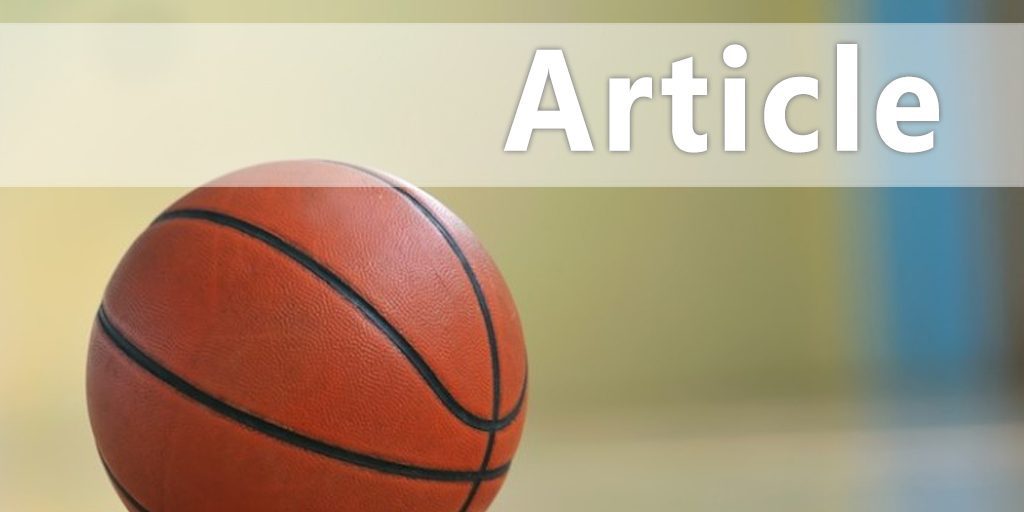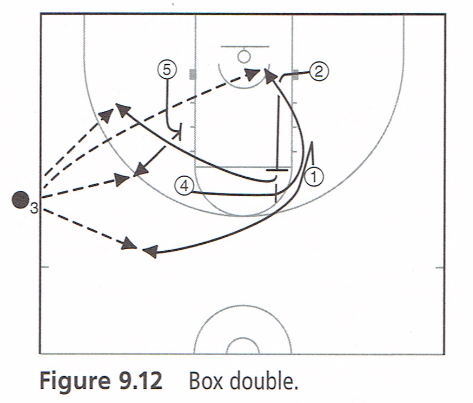| Scoring Plays From the Frontcourt - Last Possession |
| By: Lee Rose
Originally Published in: Winning Basketball Fundamentals Provided by: Human Kinetics In a last possession situation when a team is behind by 3 or fewer points and has a time-out, specific issues arise. The biggest concern is getting the ball to the player who has the best chance of making the play. Coaches must keep in mind that whatever play the team runs, it must work against all types of defense. Therefore, if the defense denies the player designated to receive the pass, the other players must be alert and available for the inbounds pass. Box Double The amount of defensive pressure dictates whether the goal of the play is to get the ball inbounds and initiate a play or to attempt to score off the initial pass. This play, called the box double, is run from the free-throw line extended to midcourt and is designed to produce a score off the initial pass. Focus Looking to score from the frontcourt, side out of bounds. Procedure Play begins from the frontcourt, side out of bounds. Follow these steps: 1. Players line up in a box set. O5 and O2 are on the low blocks, and O4 and O1 are at the elbows. 2. O4 sets a cross screen for O1. O1 fakes a screen on O2 and comes off O4. 3. O5 steps up to the free-throw lane and prepares to set a screen for O2. O2 sets a back screen for O4 and continues to the sideline off O5's screen as O5 opens to the ball. 4. O3 has four possible receivers-O4 on the lob; O1, who is coming to the strong-side elbow; O2 in the corner; or O5, who is stepping to the ball after O2 clears the screen (figure 9.12). X- Out If the game clock shows 4 seconds or less, the player receiving the inbounds pass must make the play. Teammates should flatten out in the corners and not obstruct him. The player who receives the pass has plenty of time to catch, face up, and dribble a couple of times before shooting. The ball handler does not have time to run a play or gamble on a pass that may be deflected, bobbled, or mishandled. If the clock has between 5 and 10 seconds remaining, the player receiving the inbounds pass has time to run a pick-and-roll, looking to penetrate or draw and kick. The X-out play can be used in both situations, assuming that the player can create and get his own shot. X-OUT INTO PICK-AND-ROLL Focus Execution and proper alignment, down 2 points with seven seconds on the clock, side out of bounds. Procedure Play begins in the frontcourt, side out of bounds. Follow these steps: 1. O1 lines up under the net. O2 and O3 line up at the free-throw lane extended, just above the three-point line. O5 sets up just above the free-throw line. 2. O3 cuts first and goes to the left-hand corner. O2 cuts off O3's back and goes to the right-hand corner. 3. After O2 and O3 make their cuts, O5 turns and sets a down screen for O1, whose job is to get open at the top of the key by going either way off O5. 4. O4 inbounds the ball and dives to the same-side block to rebound. The alignment is now set to run a specific play. 5. In most situations, the inbounds pass will go to the point guard (O1), who is generally the team's best ball handler and can penetrate. 6. When O1 clears O5 and O4 inbounds the ball, O5 relocates at the top of the key and sets a second screen for O1 (figure 9.13). O5 then pops out for a spot-up. 7. The team's best shooter (in this case, O2) spots up in the corner on the side to which O1 drives. The offensive team is down 2 points, so O1 looks to turn the corner and attack the basket. 8. O1 has three viable options—a drive, a pass to O5, or a pass to O2. This play is designed to get the best shooters in the corners, and the point guard penetrates to the basket for the layup or a draw-and-kick. If O2 is a good ball handler as well as the best shooter, it may be wise to have O1 and O2 switch positions. When diagramming these plays during time-outs, the coach should put the players in positions where they are comfortable. Coaches should know their players' strengths, such as which side of the floor they like to shoot from or whether they prefer to go right or left on drives. Practicing special situations, a crucial aspect of game management, allows coaches to gain this knowledge. The X-out into pick-and-roll play provides excellent opportunities for scoring by several players in a variety of ways. THREE-POINT X-OUT Focus Execution and proper alignment, down 3 points, side out of bounds. Procedure Play begins in the frontcourt, side out of bounds. This play is designed to get a three-point attempt. Follow these steps: 1. The play begins with the X-out formation, which properly aligns the players. O4 prepares to inbound the ball. 2. Instead of going wide to the corner on their cuts, O2 and O3 dive to the low block on their respective sides of the court. 3. O5 sets a screen for O1, who receives the inbounds pass from O4. 4. On O4's pass inbounds to O1, O3 sets a cross screen for O2 as he sprints toward the corner. After making the pass inbounds, O4 immediately sets a second screen for O2, who runs a curl off O4, looking for a three-point catch-and-shoot. 5. After O1 clears O5's screen, O5 continues to the right-side low block and sets the last screen in the pick-the-picker screening technique for O3, who sprints to the three-point line looking for a catch-and-shoot. 6. After receiving the inbounds pass, O1 has three options: shoot if open, pass to O2 for a three-point shot, or pass to O3 for a catch-andshoot three-point attempt (figure 9.14).
This play is designed to get one of your best three-point shooters a shot. In today's game, the center, O5, may be an excellent perimeter shooter, so you may want to exchange O5 and O3's responsibilities for this special situation. |



 The player in the O4 position must be a good jumper because this play is a lob for him.
The player in the O4 position must be a good jumper because this play is a lob for him.




